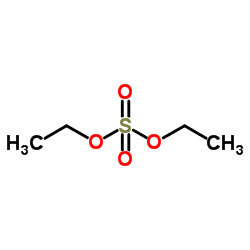Diethyl sulfate

Diethyl sulfate structure
|
Common Name | Diethyl sulfate | ||
|---|---|---|---|---|
| CAS Number | 64-67-5 | Molecular Weight | 154.185 | |
| Density | 1.2±0.1 g/cm3 | Boiling Point | 208.0±0.0 °C at 760 mmHg | |
| Molecular Formula | C4H10O4S | Melting Point | -24 °C | |
| MSDS | Chinese USA | Flash Point | 78.3±0.0 °C | |
| Symbol |



GHS05, GHS06, GHS08 |
Signal Word | Danger | |
|
Contact-dependent growth inhibition requires the essential outer membrane protein BamA (YaeT) as the receptor and the inner membrane transport protein AcrB.
Mol. Microbiol. 70 , 323-40, (2008) Contact-dependent growth inhibition (CDI) is a phenomenon by which bacterial cell growth is regulated by direct cell-to-cell contact via the CdiA/CdiB two-partner secretion system. Characterization of mutants resistant to CDI allowed us to identify BamA (YaeT... |
|
|
Genetic effects of dimethyl sulfate, diethyl sulfate, and related compounds.
Mutat. Res. 75(1) , 63-129, (1980) DMS and DES are monofunctional alkylating agents that have been shown to induce mutations, chromosomal aberrations, and other genetic alterations in a diversity of organisms. They have also been shown to be carcinogenic in animals. As an alkylating agent, DMS... |
|
|
Measurement of ethyl glucuronide, ethyl sulphate and their ratio in the urine and serum of healthy volunteers after two doses of alcohol.
Alcohol Alcohol. 48(1) , 74-82, (2013) Ethyl glucuronide (EtG) and ethyl sulphate (EtS) are minor metabolites of ethanol, and their presence in urine provides a strong indication of recent alcohol administration. In this study, we performed a drinking experiment to investigate the kinetics of EtG ... |
|
|
Monitoring of the alcohol biomarkers PEth, CDT and EtG/EtS in an outpatient treatment setting.
Alcohol Alcohol. 47(5) , 552-7, (2012) To compare the sensitivity of whole blood phosphatidylethanol (PEth) with serum carbohydrate-deficient transferrin (CDT) as biomarkers of current regular alcohol consumption, during outpatient treatment for alcohol-related problems. Urinary ethyl glucuronide ... |
|
|
Immunoassay for ethyl glucuronide in vitreous humor: a new tool for postmortem diagnostics of alcohol use.
Forensic Sci. Int. 226(1-3) , 261-5, (2013) Although excessive alcohol consumption plays a major role in fatal events, the role of alcohol use as a possible contributing factor at the time of death is not easy to establish due to lack of suitable biomarkers for postmortem analyses. We used an immunolog... |
|
|
Non-oxidative ethanol metabolites as a measure of alcohol intake.
Clin. Chim. Acta 415 , 322-9, (2013) Recent alcohol intake can be monitored by the measurement of indirect biomarkers. Elevated levels of liver enzymes (i.e. gamma-glutamyl transferase (GGT), alanine amino transferase (ALT) and aspartate amino transferase (AST)) in blood are commonly used in cli... |
|
|
Assessing the drinking status of liver transplant patients with alcoholic liver disease.
Liver Transpl. 19(4) , 369-76, (2013) The accurate assessment of drinking by patients with alcoholic liver disease is important both before and after liver transplantation. Unfortunately, self-reports by these individuals often underestimate their actual alcohol consumption. Several recently deve... |
|
|
Sensitivity and specificity of urinary ethyl glucuronide and ethyl sulfate in liver disease patients.
Alcohol. Clin. Exp. Res. 37(1) , 150-5, (2013) It is important to monitor alcohol use in the care of patients with liver disease, but patient self-report can be unreliable. We therefore evaluated the performance of urine ethyl glucuronide (EtG) and ethyl sulfate (EtS) in detecting alcohol use in the days ... |
|
|
Preliminary investigations on ethyl glucuronide and ethyl sulfate cutoffs for detecting alcohol consumption on the basis of an ingestion experiment and on data from withdrawal treatment.
Int. J. Legal Med. 126(5) , 757-64, (2012) Ethyl glucuronide (EtG) and ethyl sulfate (EtS) are commonly used alcohol markers for previous alcohol consumption. Nevertheless, the optimum EtG cutoff for urinary abstinence tests is still being discussed, and no cutoff has been recommended for EtS yet. The... |
|
|
Purpurogemutantin and purpurogemutantidin, new drimenyl cyclohexenone derivatives produced by a mutant obtained by diethyl sulfate mutagenesis of a marine-derived Penicillium purpurogenum G59.
Mar. Drugs 10(6) , 1266-87, (2012) Two new drimenyl cyclohexenone derivatives, named purpurogemutantin (1) and purpurogemutantidin (2), and the known macrophorin A (3) were isolated from a bioactive mutant BD-1-6 obtained by random diethyl sulfate (DES) mutagenesis of a marine-derived Penicill... |